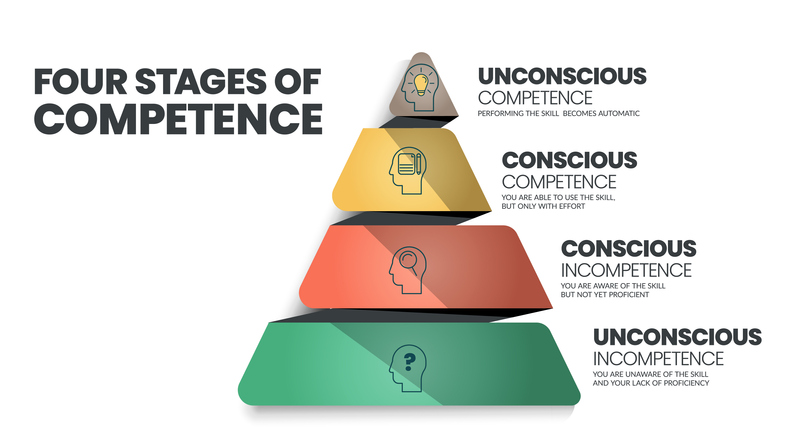Chronically seeing the glass half empty is a thought habit. Negativity toward people or ideas is also a feeling habit. Among other things, habits create our level of happiness. Change habits to increase happiness!

Our Brain’s Job is to Follow Habits
Maintaining habits is the primary job of our brain. That’s why starting a new fitness routine, or learning to speak more respectfully are new habits that, for a time, require conscious effort. But conscious effort over a period of time becomes a new habit that has replaced an old habit.
Stages of Creating a New Habit

The green level on this illustration represents doing something that has negative consequences but we’re unaware…or unconscious…that what we are doing creates that consequence.
The orange level is when we learn what we’re doing that is creating a negative consequence, but we keep doing it because it’s such a strong habit.
The yellow level is when we practice a new habit, and love the better results we’re getting, but it still requires conscious effort to practice that new habit.
We’ve arrived at the gray level when we’ve practiced a new habit long enough that it becomes our new normal…without having to work hard to remember it.
Negativity as a Bad Habit
Studies indicate we each have a certain level of happiness or unhappiness that is consistently maintained…a habit. If TEN is pure joy, and ONE is abject misery, what number represents your habitual level of happiness? A THREE? A SEVEN?
If you consciously choose to stop criticizing your partner, and, instead, choose to find at least one appreciation per day, it improves the happiness level of your relationship. If you choose to schedule a fun date with her at least every two weeks, you’ll find she’s much happier with you. Respectful, non-attacking communication definitely improves your happiness number!
Consequences of Increasing Happiness
When Jim and I quit fighting and were consistently respectful and loving with each other, I felt a low level of nagging anxiety. I wondered why? I finally had the loving marriage I’d longed for! Many couples at this stage have a big fight…go back to their old painful habits. When they now have the skills to be respectful and resolve issues without fighting, why do they go back to the old habit that creates unhappiness? Like my anxiety, their brains are sending the message, “This peace and happiness isn’t normal! You don’t belong here. I’ll help you by taking you back to the happiness level that is normal for you!”

The source of my anxiety (and many couples’ relapses) was that I was familiar with living in an unhappy marriage. Enjoying a happy marriage was unfamiliar…not yet normal. My brain was resisting the greater level of happiness as abnormal. If I hadn’t been so committed to maintaining respectful communication with Jim, I may have picked a fight to get back to “normal.” Instead, however, whenever I felt that anxiety, I reassured myself. “It’s OK to be happy with Jim. It’s safe to be in a happy, loving marriage now.” I knew that eventually my brain would relax into this new habit of happiness. We enjoyed seventeen more years together in a constant flow of mutual respect and love. That was our new normal. Unhappiness is a hard habit to break, but can be done when we change habits to increase happiness.
Adopting the Negativity of a Parent
Often, without intending to, we adopt the happiness number modeled for us by a parent. One client admits being very critical of her husband just like her mom was with her dad. She wants to change that habit, but is finding it hard. Negativity (or unhappiness) is a hard habit to break! But by consistently choosing new communication skills, and practicing them, over time she’ll become comfortable with a much higher level of happiness with her husband. And, she’ll have broken the legacy of criticalness that she inherited from her mother. She’s changing the legacy being given to her children…and future generations because she was willing to change habits to increase happiness.
A friend of mine shared her observations of four generations of a particular family. The oldest member my friend knew was the grandmother…an extremely self-centered and critical woman who frequently lied. That woman’s daughter, grand-daughter, and now great-grand-daughter have followed the pattern she modeled for them. Even though their relationship habits have produced a very low level of happiness, so far, they are remaining on the green level of the learning pyramid. Their habit is to blame others for their unhappiness, rather than learning that their unhappiness is a natural consequence of poor relationship behaviors.
Move to a Higher Level of Happiness

Even as a child I was depressed…unhappy. That unhappiness created a driving need in me to find answers that would help me be happier. That driving force led to the awareness that my poor relationship skills were a large cause of my unhappiness. I’ve also recognized that my tendency to worry keeps my happiness level lower than I would like. Learning and practicing new relationship skills enormously upgraded my happiness number. My spiritual practice of gratitude and trust enables me to be pretty happy most of the time. The courses I offer, the books I’ve written and the other resources available to you all came about as a result of my drive to be happier.
It is possible to improve your happiness number! It requires desire, a willingness to learn and change, and determination to practice those changes long enough that your brain complies with the “new normal.”
You have my love and support,


